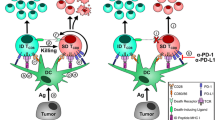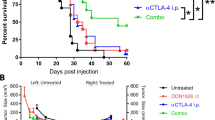Abstract
Cytotoxic chemotherapies may expose the immune system to high levels of tumor antigens and expand the CD8+ T-cell response to include weak or subdominant antigens. Here, we evaluated the in vivo CTL response to tumor antigens using a murine mesothelioma tumor cell line transfected with a neotumor antigen, ovalbumin, that contains a known hierarchy of epitopes for MHC class I molecules. We show that as tumors progress, effector CTLs are generated in vivo that focus on the dominant epitope SIINFEKL, although a weak response was seen to one (KVVRFDKL) subdominant epitope. These CTLs did not prevent tumor growth. Cisplatin treatment slowed tumor growth, slightly improved in vivo SIINFEKL presentation to T cells and reduced SIINFEKL-CTL activity. However, the CTL response to KVVRFDKL was amplified, and a response to another subdominant epitope, NAIVFKGL, was revealed. Similarly, gemcitabine cured most mice, slightly enhanced SIINFEKL presentation, reduced SIINFEKL-CTL activity yet drove a significant CTL response to NAIVFKGL, but not KVVRFDKL. These NAIVFKGL-specific CTLs secreted IFNγ and proliferated in response to in vitro NAIVFKGL stimulation. IL-2 treatment during chemotherapy refocused the response to SIINFEKL and simultaneously degraded the cisplatin-driven subdominant CTL response. These data show that chemotherapy reveals weaker tumor antigens to the immune system, a response that could be rationally targeted. Furthermore, while integrating IL-2 into the chemotherapy regimen interfered with the hierarchy of the response, IL-2 or other strategies that support CTL activity could be considered upon completion of chemotherapy.






Similar content being viewed by others
References
Nowak AK, Lake RA, Marzo AL, Scott B, Heath WR, Collins EJ, Frelinger JA, Robinson BW (2003) Induction of tumor cell apoptosis in vivo increases tumor antigen cross-presentation, cross-priming rather than cross-tolerizing host tumor-specific CD8 T cells. J Immunol 170:4905–4913
Obeid M, Panaretakis T, Tesniere A, Joza N, Tufi R, Apetoh L, Ghiringhelli F, Zitvogel L, Kroemer G (2007) Leveraging the immune system during chemotherapy: moving calreticulin to the cell surface converts apoptotic death from “silent” to immunogenic. Cancer Res 67:7941–7944
Kepp O, Tesniere A, Schlemmer F, Michaud M, Senovilla L, Zitvogel L, Kroemer G (2009) Immunogenic cell death modalities and their impact on cancer treatment. Apoptosis 14:364–375
Zitvogel L, Apetoh L, Ghiringhelli F, Kroemer G (2008) Immunological aspects of cancer chemotherapy. Nat Rev Immunol 8:59–73
Haynes NM, van der Most RG, Lake RA, Smyth MJ (2008) Immunogenic anti-cancer chemotherapy as an emerging concept. Curr Opin Immunol 20:545–557
Yewdell JW, Bennink JR (1999) Immunodominance in major histocompatibility complex class I-restricted T lymphocyte responses. Annu Rev Immunol 17:51–88
Apetoh L, Ghiringhelli F, Tesniere A et al (2007) The interaction between HMGB1 and TLR4 dictates the outcome of anticancer chemotherapy and radiotherapy. Immunol Rev 220:47–59
Chen W, Anton LC, Bennink JR, Yewdell JW (2000) Dissecting the multifactorial causes of immunodominance in class I- restricted T cell responses to viruses. Immunity 12:83–93
Flynn KJ, Belz GT, Altman JD, Ahmed R, Woodland DL, Doherty PC (1998) Virus-specific CD8+ T cells in primary and secondary influenza pneumonia. Immunity 8:683–691
Lehmann PV, Sercarz EE, Forsthuber T, Dayan CM, Gammon G (1993) Determinant spreading and the dynamics of the autoimmune T-cell repertoire. Immunol Today 14:203–208
Voskuhl RR, Farris RW 2nd, Nagasato K, McFarland HF, Dalcq MD (1996) Epitope spreading occurs in active but not passive EAE induced by myelin basic protein. J Neuroimmunol 70:103–111
Tompkins SM, Fuller KG, Miller SD (2002) Theiler’s virus-mediated autoimmunity: local presentation of CNS antigens and epitope spreading. Ann NY Acad Sci 958:26–38
Newmaster RS, Mylin LM, Fu TM, Tevethia SS (1998) Role of a subdominant H-2Kd-restricted SV40 tumor antigen cytotoxic T lymphocyte epitope in tumor rejection. Virology 244:427–441
Feltkamp MC, Vreugdenhil GR, Vierboom MP, Ras E, van der Burg SH, ter Schegget J, Melief CJ, Kast WM (1995) Cytotoxic T lymphocytes raised against a subdominant epitope offered as a synthetic peptide eradicate human papillomavirus type 16-induced tumors. Eur J Immunol 25:2638–2642
el-Shami K, Tirosh B, Bar-Haim E, Carmon L, Vadai E, Fridkin M, Feldman M, Eisenbach L (1999) MHC class I-restricted epitope spreading in the context of tumor rejection following vaccination with a single immunodominant CTL epitope. Eur J Immunol 29:3295–3301
Markiewicz MA, Fallarino F, Ashikari A, Gajewski TF (2001) Epitope spreading upon P815 tumor rejection triggered by vaccination with the single class I MHC-restricted peptide P1A. Int Immunol 13:625–632
Disis ML, Grabstein KH, Sleath PR, Cheever MA (1999) Generation of immunity to the HER-2/neu oncogenic protein in patients with breast and ovarian cancer using a peptide-based vaccine. Clin Cancer Res 5:1289–1297
Ribas A, Timmerman JM, Butterfield LH, Economou JS (2003) Determinant spreading and tumor responses after peptide-based cancer immunotherapy. Trends Immunol 24:58–61
Butterfield LH, Ribas A, Dissette VB et al (2003) Determinant spreading associated with clinical response in dendritic cell-based immunotherapy for malignant melanoma. Clin Cancer Res 9:998–1008
Ranieri E, Kierstead LS, Zarour H, Kirkwood JM, Lotze MT, Whiteside T, Storkus WJ (2000) Dendritic cell/peptide cancer vaccines: clinical responsiveness and epitope spreading. Immunol Invest 29:121–125
Jackaman C, Bundell CS, Kinnear BF, Smith AM, Filion P, van Hagen D, Robinson BW, Nelson DJ (2003) IL-2 intratumoral immunotherapy enhances CD8+ T cells that mediate destruction of tumor cells and tumor-associated vasculature: a novel mechanism for IL-2. J Immunol 171:5051–5063
Nowak AK, Robinson BW, Lake RA (2003) Synergy between chemotherapy and immunotherapy in the treatment of established murine solid tumors. Cancer Res 63:4490–4496
Nowak AK, Robinson BW, Lake RA (2002) Gemcitabine exerts a selective effect on the humoral immune response: implications for combination chemo-immunotherapy. Cancer Res 62:2353–2358
Monden N, Abe S, Hishikawa Y, Yoshimura H, Kinugasa S, Dhar DK, Tachibana M, Nagasue N (1999) The role of P-glycoprotein in human gastric cancer xenografts in response to chemotherapy. Int J Surg Investig 1:3–10
Chen W, Khilko S, Fecondo J, Margulies DH, McCluskey J (1994) Determinant selection of major histocompatibility complex class I-restricted antigenic peptides is explained by class I-peptide affinity and is strongly influenced by nondominant anchor residues. J Exp Med 180:1471–1483
Lipford GB, Hoffman M, Wagner H, Heeg K (1993) Primary in vivo responses to ovalbumin. Probing the predictive value of the Kb binding motif. J Immunol 150:1212–1222
Nelson D, Bundell C, Robinson B (2000) In vivo cross-presentation of a soluble protein antigen: kinetics, distribution, and generation of effector CTL recognizing dominant and subdominant epitopes. J Immunol 165:6123–6132
Nelson DJ, Mukherjee S, Bundell C, Fisher S, van Hagen D, Robinson B (2001) Tumor progression despite efficient tumor antigen cross-presentation and effective “arming” of tumor antigen-specific CTL. J Immunol 166:5557–5566
Chen W, Khilko S, Fecondo J, Margulies DH, McCluskey J (1994) Determinant selection of major histocompatibility complex class I-restricted antigenic peptides is explained by class I-peptide affinity and is strongly influenced by nondominant anchor residues. J Exp Med 180:1471–1483
Lipford GB, Hoffman M, Wagner H, Heeg K (1993) Primary in vivo responses to ovalbumin. Probing the predictive value of the Kb binding motif. J Immunol 150:1212–1222
Jackaman C, Lew AM, Zhan Y, Allan JE, Koloska B, Graham PT, Robinson BW, Nelson DJ (2008) Deliberately provoking local inflammation drives tumors to become their own protective vaccine site. Int Immunol 20:1467–1479
Jackaman C, Cornwall S, Graham PT, Nelson DJ (2011) CD40-activated B cells contribute to mesothelioma tumor regression. Immunol Cell Biol 89:255–267
Sharma A, Ramanjaneyulu A, Ray R, Rajeswari MR (2009) Involvement of high mobility group B proteins in cisplatin-induced cytotoxicity in squamous cell carcinoma of skin. DNA Cell Biol 28:311–318
Martins I, Kepp O, Schlemmer F et al (2011) Restoration of the immunogenicity of cisplatin-induced cancer cell death by endoplasmic reticulum stress. Oncogene 30:1147–1158
Buttiglieri S, Galetto A, Forno S, De Andrea M, Matera L (2003) Influence of drug-induced apoptotic death on processing and presentation of tumor antigens by dendritic cells. Int J Cancer 106:516–520
Tesniere A, Schlemmer F, Boige V et al (2010) Immunogenic death of colon cancer cells treated with oxaliplatin. Oncogene 29:482–491
Subklewe M, Sebelin K, Block A, Meier A, Roukens A, Paludan C, Fonteneau JF, Steinman RM, Munz C (2005) Dendritic cells expand Epstein Barr virus specific CD8+ T cell responses more efficiently than EBV transformed B cells. Hum Immunol 66:938–949
Larsson M, Wilkens DT, Fonteneau JF et al (2002) Amplification of low-frequency antiviral CD8 T cell responses using autologous dendritic cells. AIDS 16:171–180
Mok H, Lee S, Wright DW, Crowe JE Jr (2008) Enhancement of the CD8+ T cell response to a subdominant epitope of respiratory syncytial virus by deletion of an immunodominant epitope. Vaccine 26:4775–4782
Grufman P, Wolpert EZ, Sandberg JK, Karre K (1999) T cell competition for the antigen-presenting cell as a model for immunodominance in the cytotoxic T lymphocyte response against minor histocompatibility antigens. Eur J Immunol 29:2197–2204
Vallbracht S, Jessen B, Mrusek S, Enders A, Collins PL, Ehl S, Krempl CD (2007) Influence of a single viral epitope on T cell response and disease after infection of mice with respiratory syncytial virus. J Immunol 179:8264–8273
Cheuk E, Chamberlain JW (2005) Strong memory CD8+ T cell responses against immunodominant and three new subdominant HLA-B27-restricted influenza A CTL epitopes following secondary infection of HLA-B27 transgenic mice. Cell Immunol 234:110–123
Basso S, Zecca M, Merli P et al (2011) T cell therapy for nasopharyngeal carcinoma. J Cancer 2:341–346
Melief CJ, Kast WM (1994) Prospects for T cell immunotherapy of tumours by vaccination with immunodominant and subdominant peptides. Ciba Found Symp 187:97–104
Makki A, Weidt G, Blachere NE, Lefrancois L, Srivastava PK (2002) Immunization against a dominant tumor antigen abrogates immunogenicity of the tumor. Cancer Immun 2:4
Reynolds P, Gordon TP, Purcell AW, Jackson DC, McCluskey J (1996) Hierarchical self-tolerance to T cell determinants within the ubiquitous nuclear self-antigen La (SS-B) permits induction of systemic autoimmunity in normal mice. J Exp Med 184:1857–1870
Miller SD, Vanderlugt CL, Begolka WS, Pao W, Yauch RL, Neville KL, Katz-Levy Y, Carrizosa A, Kim BS (1997) Persistent infection with Theiler’s virus leads to CNS autoimmunity via epitope spreading. Nat Med 3:1133–1136
Schoenberger SP, Sercarz EE (1996) Harnessing self-reactivity in cancer immunotherapy. Semin Immunol 8:303–309
Wang HB, Shi FD, Li H, Chambers BJ, Link H, Ljunggren HG (2001) Anti-CTLA-4 antibody treatment triggers determinant spreading and enhances murine myasthenia gravis. J Immunol 166:6430–6436
Acknowledgments
This work was supported by the Cancer Council of Western Australia and the Dust Diseases Board of New South Wales.
Conflict of interest
The authors declare that they have no conflict of interest.
Author information
Authors and Affiliations
Corresponding author
Electronic supplementary material
Below is the link to the electronic supplementary material.
Rights and permissions
About this article
Cite this article
Jackaman, C., Majewski, D., Fox, S.A. et al. Chemotherapy broadens the range of tumor antigens seen by cytotoxic CD8+ T cells in vivo. Cancer Immunol Immunother 61, 2343–2356 (2012). https://doi.org/10.1007/s00262-012-1307-4
Received:
Accepted:
Published:
Issue Date:
DOI: https://doi.org/10.1007/s00262-012-1307-4




